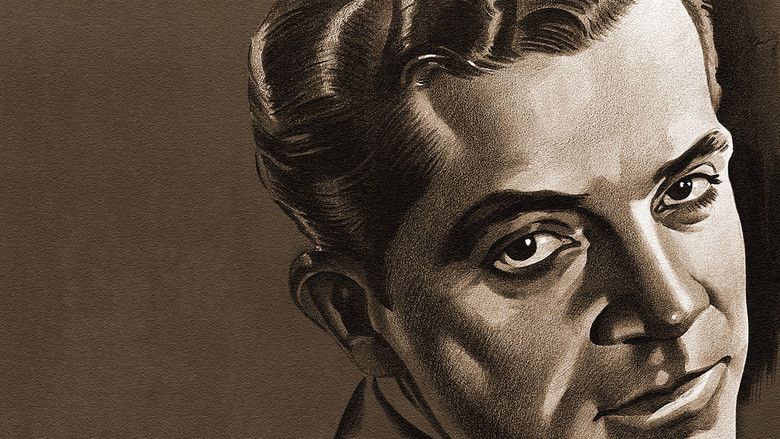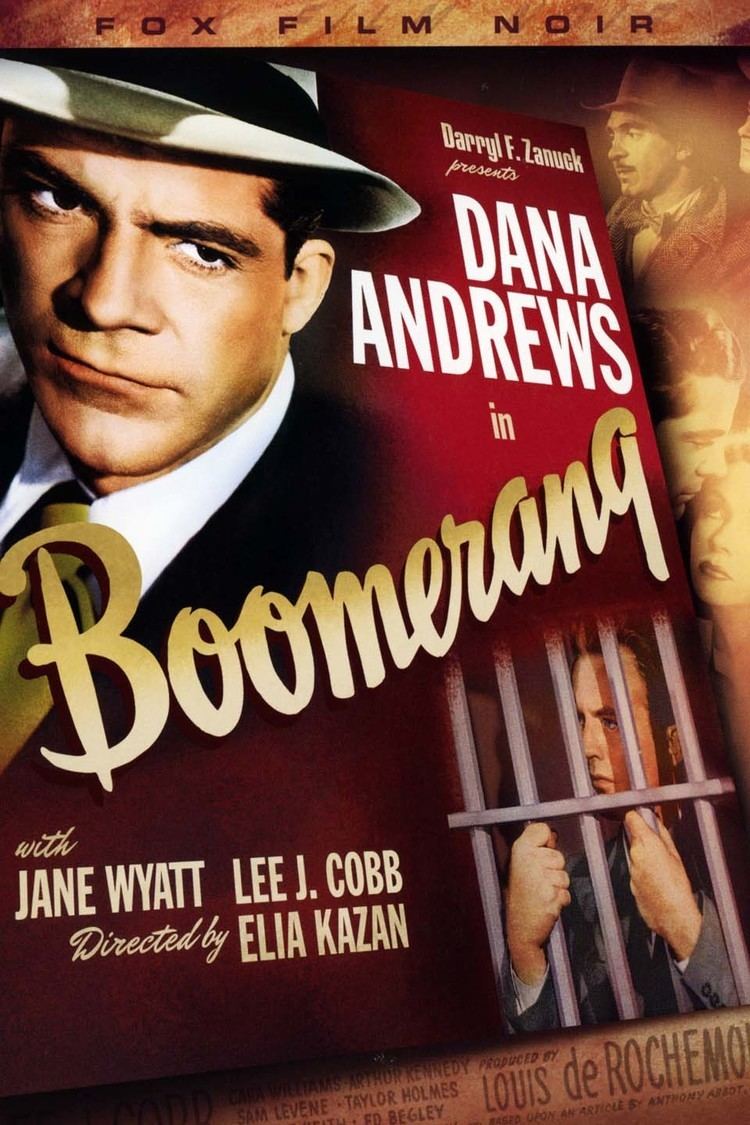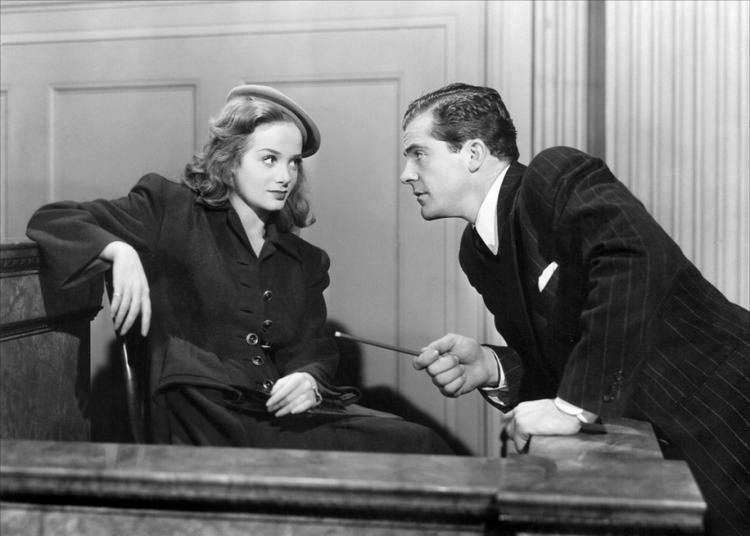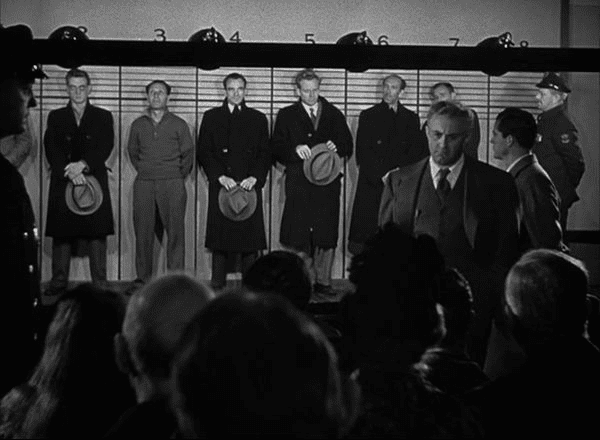Boomerang (1947 film)
7.6 /10 1 Votes
77% Rotten Tomatoes Genre Crime, Drama, Film-Noir Duration Language English | 7.3/10 IMDb Country United States | |||||||||||||||||||||||||||||||||
 | ||||||||||||||||||||||||||||||||||
Release date March 5, 1947 (1947-03-05) (United States) Based on The Perfect Case1945 article inThe Readers Digest by Anthony Abbot Writer Richard Murphy (screenplay), Fulton Oursler (based upon an article published in The Readers Digest December, 1945) Film series 20th Century Fox Film Noir Cast (State's Atty. Henry L. Harvey), (Madge Harvey), (Chief Harold F. 'Robbie' Robinson), (Irene Nelson), (John Waldron), (Dave Woods) Similar movies The Big Sleep , The Asphalt Jungle , Detour , Double Indemnity , They Live by Night , Notorious Tagline It comes back at you again and again! | ||||||||||||||||||||||||||||||||||
Boomerang! is a 1947 American crime film noir based on the true story of a vagrant who was accused of murder, only to be found not guilty through the efforts of the prosecutor. It stars Dana Andrews, Lee J. Cobb, Karl Malden, Arthur Kennedy and Jane Wyatt.
Contents
- Boomerang
- Plot
- Cast
- Factual basis
- Filming locations
- Critical response
- Awards and honors
- Adaptations to other media
- References

The film was directed by Elia Kazan, based on a story (written by Fulton Oursler, credited as "Anthony Abbot") in Reader's Digest and was shot largely in Stamford, Connecticut after Kazan was denied permission to film in Bridgeport, Connecticut, where the actual events occurred. This semidocumentary also contains voice-overs by Reed Hadley. The film was entered into the 1947 Cannes Film Festival.

Boomerang
Plot

Father Lambert (Wyrley Birch), a priest, is shot dead on a Bridgeport, Connecticut street at night. The police, led by Chief Robinson (Lee J. Cobb), fail to immediately find the murderer. It soon becomes a political hot potato, with the police accused of incompetence, and the city's reform-minded administration comes under attack. Robinson and the prosecutor Henry Harvey (Dana Andrews) come under severe pressure by political leaders to find the killer or bring in outside help.

After strenuous efforts yield nothing, a vagrant ex-serviceman, John Waldron (Arthur Kennedy), is apprehended and identified in a lineup. He is interrogated for two days by police until, deprived of sleep, he confesses. The evidence seems solid, and a gun in his possession is believed to be the gun that was used in the shooting.

Harvey, however, is not convinced. He questions Waldron, investigates the evidence and the witnesses. Harvey then risks his reputation and incurs the wrath of the police and the public in proposing that the defendant is innocent, while he and his wife (Jane Wyatt) are also being threatened by a businessman named Harris (Ed Begley). In court, even though he is the prosecutor, Harvey lays out the flaws in the case before the judge, and indicates he intends to dismiss the charges. The judge suspects Harvey's motives; Harvey's relationship with Chief Robinson is strained; and a mob unsuccessfully attempts to impose their own justice on Waldron.

A sub-plot involving Paul Harris and a property under consideration for sale to the city—at a price Harris desperately needs to keep himself afloat—also has a prominent place in the film. Harris tries to blackmail Harvey by threatening to destroy his wife, a City Council member, unless he supports the sale and sits idle, allowing Waldron to be convicted.
At a preliminary hearing, Harvey once again presents evidence that would lead to Waldron's exoneration. When a reporter gets wind of the double-dealing and threatens Harris with exposure, Harris commits suicide in the courtroom.
The film ends with a narration that the murder was never solved, and the real Henry Harvey was Homer Cummings who rose to the position of U.S. Attorney General.
Cast
Factual basis
The film is based on an actual murder case in Bridgeport, Connecticut in 1924. While walking near the Lyric Theatre in downtown Bridgeport, the Rev. Hubert Dahme ("Father George Lambert" in the film) was fatally shot behind the left ear by a gun fired at close range. Those in the theatre were so shocked that no one thought to call for an ambulance until 10 minutes had passed. Two hours later, the priest was pronounced dead at St. Vincent's Hospital in Bridgeport. A vagrant and discharged soldier, Harold Israel, was indicted for the murder. Israel confessed to the crime, and a .32 revolver was found in his possession that police believe was used in the murder. Fairfield County, Connecticut state's attorney Homer Cummings conducted a thorough investigation and found Israel innocent of the crime. Cummings (named "Henry Harvey" in the film) later became Attorney General of the United States under Franklin D. Roosevelt. The Morning Record was the name used in the film for the Bridgeport Post (now the Connecticut Post).
Filming locations
Almost all of the film was shot in Stamford, Connecticut, except for the courtroom scene shot in White Plains, New York.
Stamford locations:
The movie premiered at the Palace Theatre in Stamford on March 5, 1947, with Kazan and Andrews in attendance. (Kazan later filmed Gentleman's Agreement which takes place in Darien, Connecticut, adjacent to Stamford, and which also included the actress Jane Wyatt.)
Critical response
When first released film critic Bosley Crowther discussed the filmmaking, writing the "...style of presentation has resulted in a drama of rare clarity and punch."
The staff at Variety gave the film a positive review and wrote, "Boomerang! is gripping, real-life melodrama, told in semi-documentary style. Lensing was done on location at Stamford, Conn, the locale adding to realism. Based on a still unsolved murder case in Bridgeport, Conn, plot is backed up with strong cast...All the leads have the stamp of authenticities. The dialog and situations further the factual technique. Lee J. Cobb shows up strongly as chief detective, harassed by press and politicians alike while trying to carry out his duties. Arthur Kennedy is great as the law's suspect."
Awards and honors
Wins
Nominations
The film is recognized by American Film Institute in these lists:
Adaptations to other media
Boomerang was dramatized as a half-hour radio play on the November 10, 1947 broadcast of the Screen Guild Theater with Dana Andrews and Jane Wyatt, on the January 14, 1949 broadcast of the Ford Theatre with Dana Andrews and lastly, on Hollywood Sound Stage with Tyrone Power and Jane Wyatt on February 28, 1952.
References
Boomerang (1947 film) WikipediaBoomerang! (1947 film) IMDbBoomerang! (1947 film) Rotten TomatoesBoomerang (1947 film) themoviedb.org
